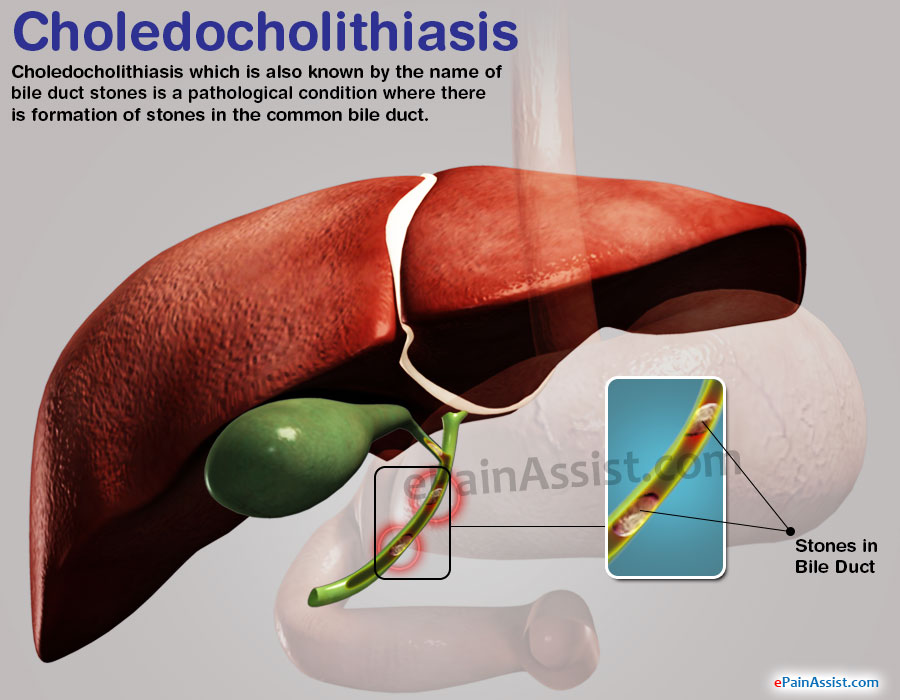What Is Choledocholithiasis?
Choledocholithiasis which is also known by the name of bile duct stones is a pathological condition where there is formation of stones in the common bile duct. Usually stones develop in the gallbladder, but sometimes the stones pass the gallbladder into the common bile duct thus obstructing the bile duct causing numerous symptoms. The bile duct is a tube which connects the gallbladder to the small intestine. Research suggests that approximately 20% of people who have gallstones go on to develop Choledocholithiasis.

What Causes Choledocholithiasis?
Usually gallstones are of two types which are the cholesterol stones and the pigment stones. Research suggests that cholesterol stones are formed by bile which contains excess cholesterol, excessive bilirubin, and inadequate bile salts.
Why pigment stones form is not entirely clear, but they are normally seen in people with the following medical condition:
- Liver cirrhosis
- Infection of the biliary tract
- Liver dysfunction in which too much bilirubin is produced.
What Are The Risk Factors For Choledocholithiasis?
If an individual has a prior history of gallstones then he or she is at an increased risk for Choledocholithiasis or Bile Duct Stones. Some of the other risk factors for Choledocholithiasis are:
- Being overweight increases the chances of developing Choledocholithiasis.
- Eating a low-fiber high fat diet also increases the chances of it.
- Pregnancy also plays a role in development of Choledocholithiasis.
- In case where people are involved in prolonged fasting that also increases the risk for Choledocholithiasis or Bile Duct Stones.
- Rapid weight loss is also a factor in development of it.
- Being sedentary increases the risk of developing Choledocholithiasis
- Choledocholithiasis is seen more in the elderly population
- Females are more likely to develop it than males.
What Are The Symptoms of Choledocholithiasis?
Normally Choledocholithiasis does not produce any symptoms and may get unnoticed for many months until the block becomes severe in which case the following symptoms may be observed:
- Upper or middle quadrant abdominal pain
- Fever
- Jaundice
- Loss of appetite
- Nausea with vomiting.
If the stone gets stuck in the bile duct then there are greater chances of infection and this infection can spread to other parts of the body like the liver rather quickly which can be potentially dangerous. The pain caused due to Choledocholithiasis or bile duct stones may come and go at times or at times may stay there for a long time. It may be mild to start with and then gradually becomes severe.
How Is Choledocholithiasis Diagnosed?
When you present to a healthcare provider with the above mentioned symptoms the physician may order the following tests in order to confirm the diagnosis of Choledocholithiasis:
Transabdominal Ultrasound: This is a radiographic procedure in which high frequency sound waves are used to produce images of the abdominal area and stones can be easily visualized using this procedure.
Abdominal CT scan: This study can also be done to look at the interior structures of the abdomen and confirm the presence of gallstones or stones of the common bile duct.
Endoscopic Retrograde Cholangiography: Also known by the name of ERCP, this is the most preferred procedure to identify any stones or tumors in the bile duct.
Apart from the above studies the physician may also perform certain tests to include:
- Complete blood count
- Bilirubin levels
- Pancreatic enzyme levels
- Liver function tests.

How Is Choledocholithiasis Treated?
The basic treatments for treating Choledocholithiasis or Bile Duct Stones are:
- Stone extraction
- Lithotripsy
- Cholecystectomy
- Sphincterotomy
- Biliary stenting.
Out of the above mentioned treatment options, the most preferred method for treating Choledocholithiasis is biliary endoscopic sphincterotomy. In this procedure, a device is inserted into the bile duct and is used to extract the stones. This procedure has a success rate of about 90% which means that in about 90% of people all the stones are removed successfully by this procedure.
In case of the bile duct stones are not able to be removed by biliary endoscopic sphincterotomy then the physician may recommend trying out lithotripsy. In this procedure the stones are fragmented first and then captured.
If still the bile duct stones are not able to be removed then complete removal of the gallbladder is recommended.
In case of you do not want to remove the gallbladder and the stones are not treated by any of the above mentioned procedures then the physician may use biliary stents to widen the bile duct so as to allow the stones to pass and relieve the blockage caused due to Choledocholithiasis.
- MedlinePlus: Bile Duct Diseases – https://medlineplus.gov/bileductdiseases.html
